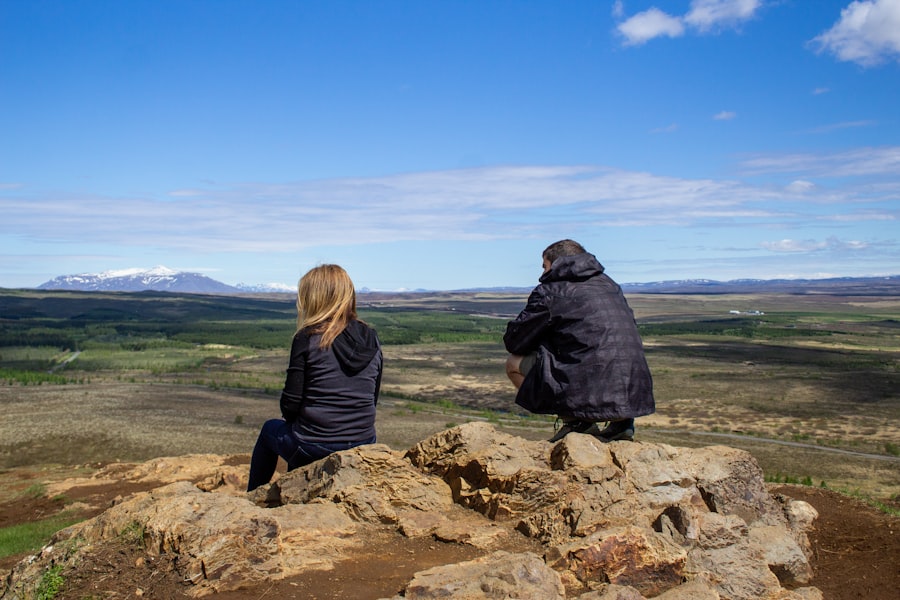Download links
How to install Discovering the Mysterious Chocolate Hills APK?
1. Tap the downloaded Discovering the Mysterious Chocolate Hills APK file.
2. Touch install.
3. Follow the steps on the screen.
Description
The Chocolate Hills, a geological wonder located in the Bohol province of the Philippines, are steeped in local folklore and legend. One of the most popular tales recounts the story of two giants, Arogo and Aluya, who fell in love with a mortal woman. Arogo, a giant known for his strength and beauty, was deeply enamored with Aluya, but their love was not meant to be.
After Aluya’s untimely death, Arogo was heartbroken and wept for days. His tears formed the hills that we see today, while the green grass that covers them turns brown during the dry season, resembling chocolate. This poignant tale not only explains the hills’ unique appearance but also reflects the deep emotional connection that the local people have with their natural landscape.
Another legend tells of a fierce battle between two rival giants who hurled boulders at each other in a fit of rage. After their conflict ended, they left behind the mounds of earth that became the Chocolate Hills. This narrative emphasizes themes of rivalry and reconciliation, illustrating how natural formations can be imbued with human emotions and experiences.
These legends serve as a cultural touchstone for the people of Bohol, providing a sense of identity and belonging while also attracting visitors who are eager to learn about the rich tapestry of local mythology.
Key Takeaways
- The Chocolate Hills are a natural wonder in the Philippines, consisting of over 1,200 cone-shaped hills.
- The geological formation of the Chocolate Hills is still a subject of debate, with theories ranging from coral reefs to volcanic eruptions.
- The Chocolate Hills are home to a diverse range of flora and fauna, including the endangered tarsier and various species of orchids and ferns.
- As a popular tourist destination, the Chocolate Hills offer activities such as hiking, zip-lining, and ATV tours.
- Conservation efforts for the Chocolate Hills are ongoing, with initiatives to protect the environment and wildlife, and promote sustainable tourism.
Geological Formation of the Chocolate Hills
Formation Process
The formation of the Chocolate Hills began millions of years ago when marine limestone was deposited on the ocean floor. Over time, tectonic activity lifted these deposits above sea level. Erosion played a crucial role in shaping the hills into their current form.
Shaping the Hills
Rainwater, along with natural elements, gradually wore away softer materials, leaving behind the more resistant limestone structures. The unique conical shapes are a result of this selective erosion process, which has been ongoing for thousands of years.
A Seasonal Transformation
The hills are particularly striking during the dry season when the grass covering them turns brown, giving them their chocolate-like appearance. This seasonal transformation adds to their allure and has contributed to their name. The scientific understanding of these formations not only enhances our appreciation for their beauty but also underscores the dynamic processes that shape our planet.
Flora and Fauna of the Chocolate Hills

The Chocolate Hills are not just a geological marvel; they also host a diverse array of flora and fauna that thrive in this unique environment. The hills are primarily covered with grass, which turns brown during the dry season but remains lush and green during the rainy months. This seasonal variation supports various plant species adapted to the changing conditions.
Among these are several types of grasses, shrubs, and flowering plants that contribute to the ecological diversity of the region. In addition to plant life, the Chocolate Hills are home to various animal species that inhabit this unique ecosystem. Birds such as the Philippine tarsier, one of the world’s smallest primates, can be found in the surrounding areas.
These nocturnal creatures are known for their large eyes and remarkable agility, making them a fascinating subject for wildlife enthusiasts. Other species include various reptiles and insects that play essential roles in maintaining the ecological balance within this environment. The presence of such diverse flora and fauna highlights the importance of preserving this unique landscape, as it serves as a habitat for numerous species that may be endemic to the region.
The Chocolate Hills as a Tourist Destination
| Metrics | Data |
|---|---|
| Number of hills | 1,268 |
| Location | Bohol, Philippines |
| Height of hills | 30 to 50 meters |
| Area covered | 50 square kilometers |
| Best time to visit | Dry season (November to May) |
| Activities | Sightseeing, hiking, photography |
As one of the Philippines’ most iconic landmarks, the Chocolate Hills attract thousands of tourists each year. Their unique geological features and stunning vistas make them a must-visit destination for both local and international travelers. The hills are easily accessible from major cities in Bohol, with well-maintained roads leading to viewing platforms that offer panoramic views of this breathtaking landscape.
Tourists often flock to these vantage points to capture photographs that showcase the hills’ distinctive shapes against the backdrop of a vibrant sky. In addition to sightseeing, visitors can engage in various activities that enhance their experience at the Chocolate Hills. Guided tours provide insights into the geological history and cultural significance of the area, allowing tourists to appreciate not just the visual beauty but also the stories behind these formations.
Local tour operators often offer packages that include visits to nearby attractions, such as the Tarsier Sanctuary or Loboc River, creating a comprehensive experience that showcases Bohol’s rich natural and cultural heritage. The growing popularity of eco-tourism has further elevated the status of the Chocolate Hills as a premier destination for those seeking adventure and exploration in a stunning natural setting.
Conservation Efforts for the Chocolate Hills
Recognizing the ecological and cultural significance of the Chocolate Hills, various conservation efforts have been initiated to protect this unique landscape from environmental degradation and over-tourism. Local government units, in collaboration with environmental organizations, have implemented measures aimed at preserving both the geological formations and their surrounding ecosystems. These initiatives include reforestation projects designed to restore native vegetation and prevent soil erosion, which is crucial for maintaining the integrity of the hills.
Moreover, educational programs have been established to raise awareness among visitors about responsible tourism practices. By promoting sustainable behaviors such as minimizing waste and respecting wildlife habitats, these programs aim to foster a sense of stewardship among tourists and locals alike. Additionally, regulations have been put in place to limit construction and development in sensitive areas surrounding the Chocolate Hills, ensuring that future generations can enjoy this natural wonder without compromising its ecological balance.
Cultural Significance of the Chocolate Hills

The Chocolate Hills hold profound cultural significance for the people of Bohol, serving as a symbol of their identity and heritage. Beyond their geological uniqueness, these hills are woven into local folklore and traditions, reflecting the values and beliefs of the community.
The hills also play a role in community gatherings and celebrations. Local festivals often incorporate elements inspired by the Chocolate Hills, showcasing traditional music, dance, and crafts that highlight Boholano culture. This connection between nature and culture fosters a sense of pride among residents while also inviting visitors to engage with local customs and traditions.
By understanding the cultural significance of the Chocolate Hills, tourists can gain deeper insights into Bohol’s history and its people’s relationship with their environment.
Activities and Attractions around the Chocolate Hills
Visitors to the Chocolate Hills can enjoy a variety of activities that enhance their experience beyond simply admiring the landscape. Adventure seekers can partake in outdoor pursuits such as hiking or biking along designated trails that wind through the hills and surrounding areas. These trails offer opportunities for exploration while providing stunning views at every turn.
For those looking for a more leisurely experience, guided tours often include visits to nearby attractions like the Loboc River Cruise or visits to local farms where visitors can learn about traditional agricultural practices. Additionally, adventure parks have emerged in proximity to the Chocolate Hills, offering thrilling activities such as zip-lining or ATV rides through rugged terrain. These attractions cater to families and thrill-seekers alike, providing an adrenaline rush while allowing participants to appreciate the natural beauty surrounding them from different perspectives.
The combination of adventure activities with cultural experiences creates a well-rounded itinerary for visitors seeking both excitement and education during their stay in Bohol.
The Future of the Chocolate Hills
As interest in eco-tourism continues to grow globally, the future of the Chocolate Hills hinges on balancing tourism development with conservation efforts.
Sustainable tourism practices will be essential in preserving this natural wonder for future generations while allowing visitors to experience its beauty responsibly.
Moreover, ongoing research into geological processes will contribute to our understanding of how climate change may impact these formations over time. By monitoring environmental changes and implementing adaptive management strategies, local authorities can better protect this iconic landscape from potential threats posed by natural disasters or human activities. The future of the Chocolate Hills lies not only in their preservation but also in fostering a deeper appreciation for their significance among both locals and visitors alike—ensuring that this remarkable site continues to inspire awe for generations to come.
FAQs
What are the Chocolate Hills?
The Chocolate Hills are a geological formation located in the Bohol province of the Philippines. They are made up of around 1,200 to 1,776 conical limestone hills, which are covered in green grass that turns brown during the dry season, giving them a chocolate-like appearance.
How were the Chocolate Hills formed?
The exact formation process of the Chocolate Hills is still a subject of debate among geologists. One theory suggests that they are the weathered formations of a marine limestone on top of an impermeable layer of clay. Another theory proposes that they are the result of the uplift of coral deposits and the action of rainwater and erosion.
What is the significance of the Chocolate Hills?
The Chocolate Hills are a major tourist attraction in the Philippines and are considered a natural wonder. They have been declared the country’s third National Geological Monument and proposed for inclusion in the UNESCO World Heritage List.
Can visitors explore the Chocolate Hills?
Yes, visitors can explore the Chocolate Hills by climbing the viewing deck in the town of Carmen, which offers a panoramic view of the hills. There are also hiking trails and ATV tours available for those who want to explore the area more closely.
Are there any legends or myths associated with the Chocolate Hills?
According to local folklore, the Chocolate Hills were formed from the tears of a giant named Arogo, who wept uncontrollably after his true love died. Another legend tells the story of two giants who hurled rocks and sand at each other in a fit of rage, and when they reconciled, they left behind the Chocolate Hills.





